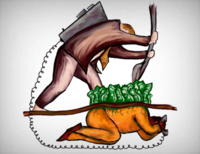

Out of Prison & Out of Work:
Unemployment among formerly incarcerated people
By Lucius Couloute and Daniel Kopf
July 2018
Formerly incarcerated people need stable jobs for the same reasons as everyone else: to support themselves and their loved ones, pursue life goals, and strengthen their communities. But how many formerly incarcerated people are able to find work? Answering this fundamental question has historically been difficult, because the necessary national data weren’t available — that is, until now.
Using a nationally representative dataset, we provide the first ever estimate of unemployment among the 5 million formerly incarcerated people living in the United States.1 Our analysis shows that formerly incarcerated people are unemployed at a rate of over 27% — higher than the total U.S. unemployment rate during any historical period, including the Great Depression.
Our estimate of the unemployment rate establishes that formerly incarcerated people want to work, but face structural barriers to securing employment, particularly within the period immediately following release. For those who are Black or Hispanic — especially women — status as “formerly incarcerated” reduces their employment chances even more. This perpetual labor market punishment creates a counterproductive system of release and poverty, hurting everyone involved: employers, the taxpayers, and certainly formerly incarcerated people looking to break the cycle.
Fortunately, as the recommendations presented in this report illustrate, there are policy solutions available that would create safer and more equitable communities by addressing unemployment among formerly incarcerated people.
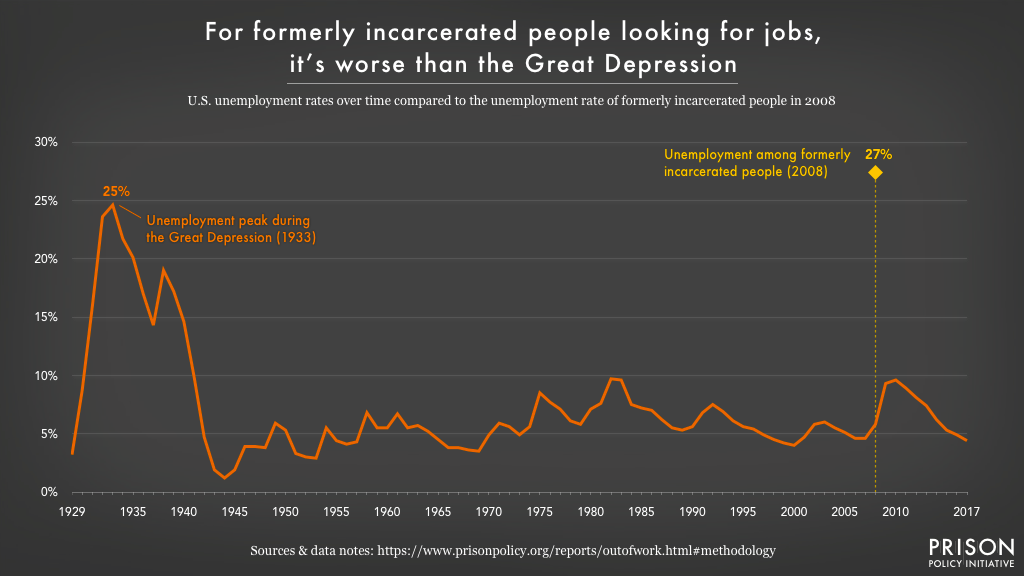
Unemployment among formerly incarcerated people
Over 600,000 people make the difficult transition from prisons to the community each year2 and although there are many challenges involved in the transition, the roadblocks to securing a job have particularly severe consequences. Employment helps formerly incarcerated people gain economic stability after release and reduces the likelihood that they return to prison,3 promoting greater public safety to the benefit of everyone. But despite the overwhelming benefits of employment, people who have been to prison are largely shut out of the labor market.4
We find that the unemployment rate5 for formerly incarcerated people is nearly five times higher than the unemployment rate for the general United States population, and substantially higher than even the worst years of the Great Depression.6 Although we have long known that labor market outcomes for people who have been to prison are poor, these results point to extensive economic exclusion that would certainly be the cause of great public concern if they were mirrored in the general population.7
These inequalities persist even when controlling for age. Among working-age individuals (25-44 in this dataset), the unemployment rate for formerly incarcerated people was 27.3%, compared with just 5.2% unemployment for their general public peers. That such a large percentage of prime working-age formerly incarcerated people are without jobs but wish to work suggests structural factors — like discrimination — play an important role in shaping job attainment.8
Prior research suggests that employers discriminate against those with criminal records, even if they claim not to. Although employers express willingness to hire people with criminal records, evidence shows that having a record reduces employer callback rates by 50%.9 What employers say appears to contradict what they actually do when it comes to hiring decisions.10
Our analysis also shows that formerly incarcerated people are more likely to be “active” in the labor market than the general public. Among 25-44 year old formerly incarcerated people, 93.3% are either employed or actively looking for work, compared to 83.8% among their general population peers of similar ages.11 Though unemployment among formerly incarcerated people is five times higher than among the general public, these results show that formerly incarcerated people want to work.
Unemployment among this population is a matter of public will, policy, and practice, not differences in aspirations.
A closer look: How employment varies by race and gender, time since release, and access to full-time work
Race and gender
In the general public, people of color tend to face higher unemployment rates than whites, while men tend to have lower unemployment rates than women. The overrepresentation of people of color and men among those who have been to prison, then, could have conceivably influenced the inequalities we observed between formerly incarcerated people and the general public.
After disaggregating by race and gender, however, we found that the unemployment rate of every formerly incarcerated group remains higher than that of any comparable group in the general public. High unemployment among formerly incarcerated people is not simply explained by the overrepresentation of people of color in the criminal justice system; it’s the status of being formerly incarcerated that sets them apart.
But the story here is intersectional. Formerly incarcerated Black women in particular experience severe levels of unemployment, whereas white men experience the lowest. Overall, we see working-age “prison penalties”12 that increase unemployment rates anywhere from 14 percentage points (for white men) to 37 percentage points (for Black women) when compared to their general population peers.13 Our findings mirror prior research establishing that both race and gender shape the economic stability of criminalized people.14
| Unemployment rate general population | Unemployment rate formerly incarcerated |
|
|---|---|---|
| Black women | 6.4% | 43.6% |
| Black men | 7.7% | 35.2% |
| White women | 4.3% | 23.2% |
| White men | 4.3% | 18.4% |
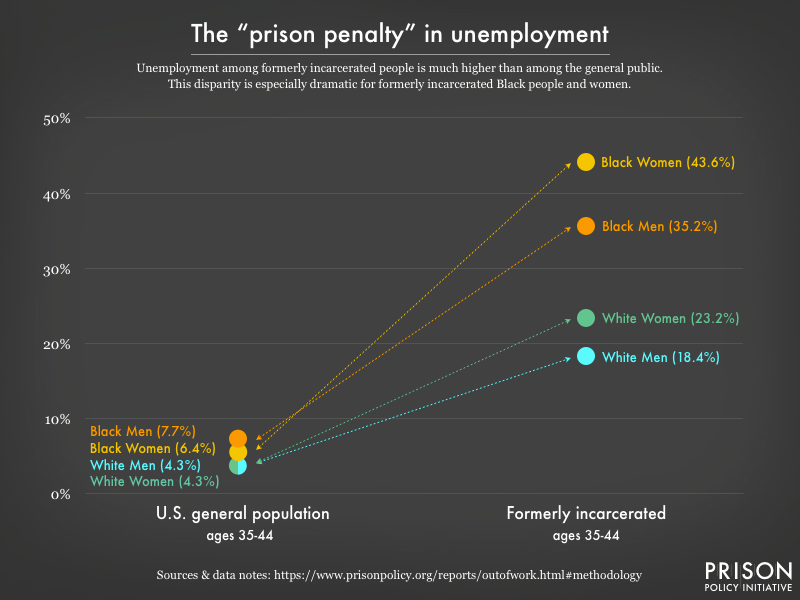
Time since release
We also find that unemployment is highest within the first two years of release, suggesting that pre- and post-release employment services are critical in order to reduce recidivism and help incarcerated people quickly integrate back into society. Of those most recently released from prison (that is, within two years of the survey date), over 30% were unemployed. Unemployment rates were lower for those released within 2-3 years of the survey (21%), and people who had been out of prison for at least 4 years reported the lowest rates of unemployment (just under 14%). 15
| Year Released (Years since release at the time of the 2008 survey) | Unemployment rate |
|---|---|
| 2007-2008 (less than 2 years since release) | 31.6% |
| 2005-2006 (2-3 years since release) | 21.1% |
| 2004 or before (4 or more years since release) | 13.6% |
The transition from prison back to the community is fraught with challenges; the search for employment is one of many tasks that can derail successful reentry. In the period immediately following release, formerly incarcerated people are likely to struggle to find housing16 and attain addiction and mental health support.17 They also face disproportionately high rates of death due to drug overdose, cardiovascular disease, homicide, and suicide within this crucial period.18 Taken together, these results make it easy to understand how various barriers to reentry operate as an interconnected system to increase inequality.
Access to full-time work
When formerly incarcerated people do land jobs, they are often the most insecure and lowest-paying positions.19 According to an analysis of IRS data by the Brookings Institution,20 the majority of employed people recently released from prison receive an income that puts them well below the poverty line.21
Our data suggests that, in combination with a criminal record, race and gender play a significant role in shaping who gets access to good jobs and livable incomes. Almost all employed formerly incarcerated white men (the group most likely to be employed) work in full-time positions, whereas Black women (the group least likely to be employed) are overrepresented in part-time and occasional jobs (see figure 3).
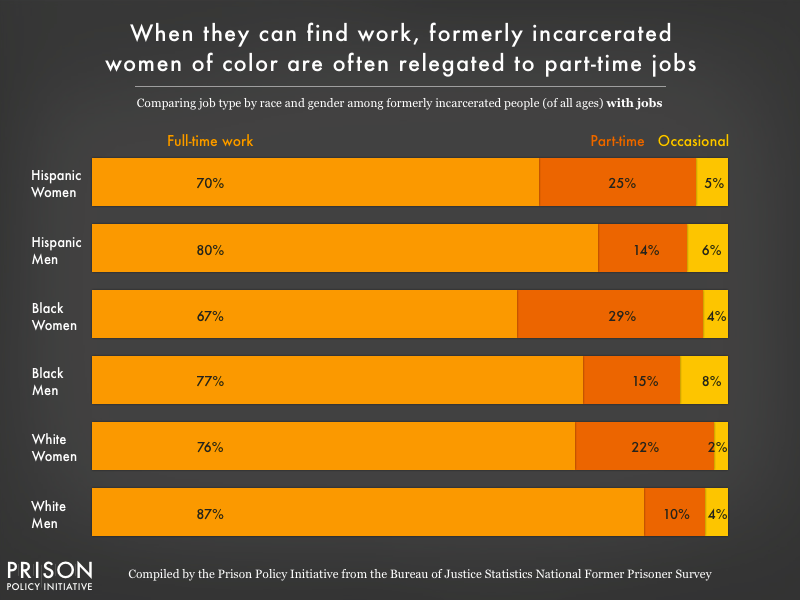
Though Black women in the general public tend to have higher rates of full-time work than their Hispanic or white peers, low rates of full-time work among formerly incarcerated Black women illustrates that gender and race operate together in the context of reentry.22
Conclusion
One of the primary concerns for people being released from prison is finding a job. But as our analysis illustrates, formerly incarcerated people are almost five times more likely than the general public to be unemployed, and many who are employed remain relegated to the most insecure jobs. Our analysis also shows that formerly incarcerated people of color and women face the worst labor market disadvantages despite being more likely to be looking for jobs (See Table 3).
Exclusionary policies and practices — not individual-level failings of criminalized people — are responsible for these labor market inequalities. Fortunately, research shows that those with prior criminal justice system contact want to work and that hiring them can benefit both employers and the general public:
- Research based on 1.3 million United States military enlistees shows that those with criminal records were promoted more quickly and to higher ranks than other enlistees, and had the same attrition rates due to poor performance as their peers without records. 23
- A study of job performance among call center employees found that individuals with criminal records had longer tenure and were less likely to quit than those without records.24
- One longitudinal study out of Johns Hopkins Hospital found that after “banning the box” on initial applications and making hiring decisions based on merit and the relevance of prior convictions to particular jobs, hired applicants with criminal records exhibited a lower turnover rate than those with no records.25
The evidence illustrates that broad stereotypes about people with criminal records have no real-world basis. But convincing employers that people with criminal records are good workers is not enough. Improving the wellbeing of formerly incarcerated people — and increasing equity in all communities — will require concerted policy efforts that address the underlying structural sources of inequality shaping the lives of criminalized people across the United States.
Recommendations
There are promising policy choices available to lawmakers at each level of government that would help formerly incarcerated people gain employment and increase public safety:
- Issue a temporary basic income upon release: Providing short-term financial stability for formerly incarcerated people would operate as an investment, helping to ease reintegration and provide public safety and recidivism reduction benefits that would result in long-term cost savings.32
- Implement automatic record expungement procedures: A prison sentence should not be a perpetual punishment. Having an automatic mechanism for criminal record expungement that takes into account the offense type and length of time since sentencing would, in the near term, help formerly incarcerated people succeed and would, in the long term, promote public safety. 31
- Make bond insurance29 and tax benefits30 for employers widely available: Some governmental bodies offer insurance and tax incentives for employers who hire people with criminal records, protecting against real or perceived risks of loss. Increasing the availability of such programs would provide hesitant employers with added financial security.
- Ban blanketed employer discrimination:26 Criminal records are not good proxies for employability. Additionally, because of racially disproportionate incarceration rates, organizations who discriminate against people with criminal records may also be contributing to racial discrimination and are therefore subject to litigation under Title VII of the Civil Rights Act of 1964.27
- Enact occupational licensing reform: Numerous occupations require prospective workers to obtain job-related state licenses. Unfortunately, acquiring such licenses often involves passing a criminal background check. States should reform their licensing practices so as to eliminate the automatic rejection of people with felony convictions.28
Appendix
Employment outcomes for formerly incarcerated people vary widely by race and gender. In the chart and table below, we explore these disparities in richer detail:
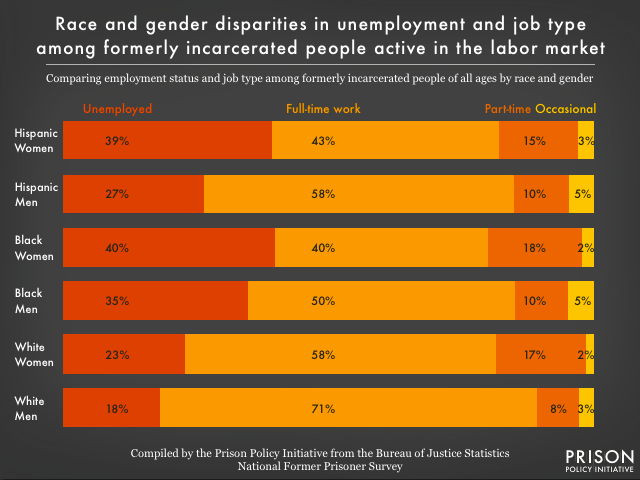
The unemployment rate in all demographic groups is different from the joblessness rate. Joblessness includes anyone who does not have a job, whether they are looking for one or not, and was, prior to our analysis, the only measurement of formerly incarcerated people’s labor market status. Unemployment, which is typically used to measure the economic well-being of the general U.S. population, includes only those people who want to work but can’t find a job. The table below provides both figures.
| Race/ethnicity | Gender | Jobless rate | Unemployment rate |
|---|---|---|---|
| Hispanic | Women | 51.39% | 39.42% |
| Men | 33.14% | 26.55% | |
| Black | Women | 51.37% | 40.00% |
| Men | 40.96% | 34.96% | |
| White | Women | 38.17% | 23.10% |
| Men | 27.17% | 18.31% |
Methodology
This report calculating an unemployment rate for formerly incarcerated people is based on our analysis of a little-known and little-used government survey, the National Former Prisoner Survey, conducted in 2008. The survey was a product of the Prison Rape Elimination Act, and is therefore primarily about sexual assault and rape behind bars, but it also contains some very useful data on employment.
Because this survey contains such sensitive and personal data, the raw data was not available publicly on the internet. Instead, it is kept in a secure data enclave in the basement of the University of Michigan Institute for Social Research. Access to the data required the approval of an independent Institutional Review Board, the approval of the Bureau of Justice Statistics, and required us to access the data under close supervision. The practicalities of having to travel across the country in order to query a computer database limited the amount of time that we could spend with the data, and other rules restricted how much data we could bring with us. For these reasons, there are two tables (Table 1 and Table 2) where, if we had the benefit of hindsight or the resources for a return trip to the enclave, we would have collected some more nuanced data to make comparisons by race/ethnicity, gender, and age even more complete. Even so, to the best of our knowledge, the analysis in this report is the only one of its kind to date.
Why we examined unemployment
Although the employment status of formerly incarcerated people is not a new subject, this report extends upon previous research by constructing an unemployment rate for formerly incarcerated people that is similar to what is typically accepted by economists: those who were not employed at the time of the survey but were available and actively looking for a job, divided by the total number of people in the labor force (Note: the Bureau of Labor Statistics considers jobless people who have looked for work in the past 4 weeks as part of the labor force. The National Former Prisoner Survey does not stipulate 4 weeks and instead asked respondents if they were currently looking for work).
Traditionally, researchers have used joblessness as a measure of post-imprisonment labor market success, a measurement that includes anyone who does not have a job, whether they are looking for one or not. Calculating the unemployment rate allows policymakers, advocates, and the general public to directly compare the labor market exclusion of formerly incarcerated people to that of the rest of the United States.
As we have done in the past,33 comparisons between the formerly incarcerated and general U.S. populations were disaggregated by factors such as age, race, and gender in order to account for the established relationships between those factors and labor market outcomes. In this way, we provide rough controls that help us examine comparable populations.
Data sources
We used the Bureau of Justice Statistics’ National Former Prisoner Survey (NFPS) as our primary data source. This survey began in January 2008 and concluded in October 2008, and was derived from the Prison Rape Elimination Act of 2003, which mandated that the Bureau of Justice Statistics investigate sexual victimization among formerly incarcerated people.
The NFPS dataset includes 17,738 adult respondents who were formerly incarcerated in state prisons and under parole supervision at the time of the survey. Individual respondents were randomly selected from a random sample of over 250 parole offices across the United States.
It is important to note that because this survey was given to people on parole, it is not a perfect tool to measure the employment experiences of all formerly incarcerated people. Some incarcerated people are released without supervision and their ability to attain employment may be different than those on parole. Previous research suggests, however, that parole officers have a minimal effect on post-release employment, far outweighed by the effect of having a criminal record. In a 2008 Urban Institute study, only 20% of formerly incarcerated men found their parole officers helpful in finding a job when surveyed two months after release; after eight months, only 13% thought their parole officers were helpful. Yet 70% of the men believed that their criminal record had negatively affected their job search.34 A more recent study finds that for people on parole in Florida, supervision did not have a significant effect on employment outcomes, although it had a positive effect for those under supervision as part of a split sentence.35 Future research should more closely examine the effect of supervision on employment.
We drew upon specific NFPS survey questions for this report:
- A2. Are you of Hispanic or Latino origin?
- A3. Which of these categories describes your race?
- B3. In what month and year were you released from prison?
- C1. Are you male, female, or transgendered?36
- F18. Do you currently have a job?
- F18a. Is it full-time, part-time, or occasional work?
- F18b. Are you looking for work?
Comparable general United States population data was gathered from the Bureau of Labor Statistics Current Population Survey.
Historical U.S. unemployment data for Figure 1 comes from two sources:
- For 1931-32, 1934, 1936-39, 1941-44, and 1946:
Stanley Lebergott. 1957. Annual Estimates of Unemployment in the United States, 1900-1954. The Measurement and Behavior of Unemployment (National Bureau of Economic Research), 211-242. Note that this source includes people age 14 and over. - For 1933, 1935, 1940, 1945, and 1947-2017:
Labor Force Statistics from the Current Population Survey. 2018. Produced using the Bureau of Labor Statistics data tool “Databases, Tables & Calculators by Subject.” This source includes people age 14 and over until 1945; starting in 1947 it includes people age 16 and over.
About the Prison Policy Initiative
The non-profit, non-partisan Prison Policy Initiative was founded in 2001 to expose the broader harm of mass criminalization and spark advocacy campaigns to create a more just society. The organization is known for its visual breakdown of mass incarceration in the U.S., as well as its data-rich analyses of how states vary in their use of punishment. The Prison Policy Initiative’s research is designed to reshape debates around mass incarceration by offering the “big picture” view of critical policy issues, such as probation and parole, women’s incarceration, and youth confinement.
The Prison Policy Initiative also works to shed light on the economic hardships faced by justice-involved people and their families, often exacerbated by correctional policies and practice. Past reports have shown that people in prison and people held pretrial in jail start out with lower incomes even before arrest, earn very low wages working in prison, yet are charged exorbitant fees for phone calls, electronic messages, and "release cards" when they get out.
About the authors
Lucius Couloute is a Policy Analyst with the Prison Policy Initiative and a PhD candidate in Sociology at the University of Massachusetts Amherst, his dissertation examines both the structural and cultural dynamics of reentry systems. His previous work with the Prison Policy Initiative examines reentry, solitary confinement, and the elimination of in-person jail visits across the country.
Daniel Kopf is an economics reporter for Quartz and and a former data scientist who has been part of our network of volunteers since February 2015. He has previously written about money bail and has co-authored several exciting statistical reports with the Prison Policy Initiative: Prisons of Poverty: Uncovering the pre-incarceration incomes of the imprisoned, Separation by Bars and Miles: Visitation in state prisons, and The Racial Geography of Mass Incarceration. Dan has a Master’s degree in Economics from the London School of Economics. He is @dkopf on Twitter.
Acknowledgements
This report benefitted from the expertise and input of many individuals. The authors are particularly indebted to Alma Castro for IRB assistance, Allen Beck for his insight into the NFPS, the ICPSR staff for their data retrieval support, Elydah Joyce for the illustrations, our Prison Policy Initiative colleagues, and the National Employment Law Project for their helpful comments.
This report was supported by a generous grant from the Public Welfare Foundation and by our individual donors, who give us the resources and the flexibility to quickly turn our insights into new movement resources.
Footnotes
S. Shannon, C. Uggen, J. Schnittker, M. Thompson, S. Wakefield, and M. Massoglia. 2017. The Growth, Scope, and Spatial Distribution of People With Felony Records in the United States, 1948-2010. Demography. ↩
E. Ann Carson. 2018. Prisoners in 2016. Bureau of justice Statistics. ↩
Mark T. Berg and Beth M. Huebner. 2011. Reentry and the Ties that Bind: An Examination of Social Ties, Employment, and Recidivism. Justice Quarterly. ↩
Michelle Natividad Rodriguez and Maurice Emsellem. 2011. 65 Million “Need Not Apply”: The Case for Reforming Criminal Background Checks for Employment. National Employment Law Project. ↩
Although most studies of post-imprisonment labor market outcomes examine important indicators such as wages and joblessness, criminal justice researchers have yet to produce an unemployment rate comparable to the general U.S. population. Using data from the National Former Prisoner Survey (NFPS), this report fills that gap by estimating a standard unemployment rate among formerly incarcerated people on parole. To our knowledge, this report is the only nationally representative study of unemployment among formerly incarcerated people currently available.
Our calculation of the unemployment rate allows us to examine the pervasiveness of labor market exclusion among formerly incarcerated people who are actively seeking work. Traditionally, researchers have used joblessness as a measure of post-imprisonment labor market success, which includes anyone who does not have a job, whether they are looking for one or not. While joblessness is a useful measure, and one that we also use, focusing on unemployment allows us to better pinpoint the structural sources of labor market inequality without falling into unfounded “culture of poverty” traps, or mistaking age or disability-based causes of joblessness for a lack of motivation. ↩
It is important to note that we are comparing the unemployment rate among formerly incarcerated people in 2008 to the general public in 2008 - which is the most recent year in which comparable data exists. Contemporary unemployment rates may differ, but we are confident that formerly incarcerated people are still substantially disadvantaged compared to the general public. We also calculated joblessness, a more commonly used indicator of post-imprisonment labor market success (see footnote 5), and found that 31.9% of 25-44 year olds who are formerly incarcerated do not have jobs. Conversely, only about 19% of their similarly aged general public peers are without jobs. ↩
It is important to note that the general public unemployment rate also includes formerly incarcerated people. If the appropriate data existed to separate out formerly incarcerated people from the general public unemployment rate we would find even larger disparities. ↩
Individual-level factors such as old age were not the primary drivers of unemployment among formerly incarcerated people. If they were, we would observe a substantial drop in the unemployment rate among the working age group. ↩
Devah Pager examined the effect of a criminal record in the labor market by sending out paired job testers (two white testers and two Black testers) where one tester in each pair was given a fictitious felony record. Pager’s audit methodology allowed her to examine the independent effects of race and criminal records. Importantly, Black job testers without criminal records were less likely to receive callbacks from employers than white job testers with criminal records. Source: Devah Pager. 2003. The Mark of a Criminal Record. American Journal of Sociology. ↩
Devah Pager and Lincoln Quillian. Walking the Talk? What Employers Say versus What They Do. American Sociological Review. ↩
This measurement is widely known as the “labor force participation rate.” We also find that the labor force participation rate of working-age formerly incarcerated men released from 2005 to 2008 is 94.9%, compared to 92% among men in the general public (suggesting that the difference between general public and formerly incarcerated labor force participation rates are not simply the product of men being overrepresented in the NFPS data). ↩
Our term “prison penalty” refers to the unemployment gap between the general public and formerly incarcerated people. Although our data should not be interpreted to say that prison alone causes high unemployment rates among formerly incarcerated people, a wealth of data suggests that going to prison does negatively affect labor market outcomes. Apart from prison itself, criminal records and pre-imprisonment structural disadvantages such as low educational levels and pervasive racial discrimination undoubtedly contribute to high unemployment rates among people who have spent time in correctional facilities. ↩
Unfortunately, because we had limited time and resources allocated to retrieving this data at the Inter-university Consortium for Political and Social Research (ICPSR) Physical Data Enclave located in Michigan, we were not able to collect all of the data we originally set out to gather. We are therefore only able to present disaggregated unemployment data for Black and white 35-44 year olds within 4 years of release (released 2005-2008). We believe, however, that this cross section of data still provides a useful comparison to Black and white men and women ages 35-44 in the general public.
Although we were not able to construct comparable Hispanic rates of unemployment by gender and age, we can compare formerly incarcerated and general public Hispanic unemployment rates by gender alone:
Unemployment rate
General population over age 20 (2008)Unemployment rate
Formerly incarcerated (2008)Hispanic women 6.9% 39.4% Hispanic men 6.8% 26.5% Bernadette Rabuy and Daniel Kopf. 2015. Prisons of Poverty: Uncovering the pre-incarceration incomes of the imprisoned Prison Policy Initiative. ↩
This analysis includes individuals 25 and older. It should also be noted that we analyzed the data on time since release on a calendar year basis, and respondents were surveyed over a 10-month period between January and October 2008. For that reason, our categories for time since release (e.g. “2-3 years since release”) are approximate. There may be some overlap between categories; for example, if a respondent was released in December 2006 and surveyed in January 2008, they would appear in our analysis in the “2-3 years since release” category, despite having only been released 13 months before the survey. ↩
Brianna Remster. 2017. A Life Course Analysis of Homeless Shelter Use among the Formerly Incarcerated. Justice Quarterly. ↩
Jeffrey Draine and Daniel B. Herman. 2007. Critical Time Intervention for Reentry From Prison for Persons With Mental Illness. Psychiatric Services. ↩
Ingrid A. Binswanger, Marc F. Stern, Richard A. Deyo, Patrick J. Heagerty, Allen Cheadle, Joann G. Elmore, and Thomas D. Koepsell. 2007. Release from Prison — A High Risk of Death for Former Inmates.The New England Journal of Medicine. ↩
Gretchen Purser. 2012. “Still Doin’ Time:” Clamoring for Work in the Day Labor Industry. The Journal of Labor & Society. ↩
Adam Looney and Nicholas Turner. 2018. Work and opportunity before and after incarceration. The Brookings Institution. ↩
Unfortunately, according to the Congressional Research Service, most states have policies limiting access to needs-based financial and social resources such as SNAP, TANF, and housing assistance for those who have been convicted of drug-related crimes. Excluding people with drug convictions from welfare provisioning undoubtedly exacerbates other reentry barriers faced by formerly incarcerated people. ↩
Alejandra Molina. 2017. For black women, finding work after prison has added challenges. The Press-Enterprise. ↩
Jennifer Hickes Lundquist, Devah Pager, and Eiko Strader. 2018. Does a Criminal Past Predict Worker Performance? Evidence from One of America’s Largest Employers. Social Forces. ↩
Dylan Minor, Nicola Persico, and Deborah M. Weiss. 2017. Criminal Background and Job Performance. Available at SSRN. ↩
Beth Avery and Phil Hernandez. 2018. https://www.nelp.org/wp-content/uploads/Ban-the-Box-Fair-Chance-State-and-Local-Guide.pdf National Employment Law Project. ↩
Lucius Couloute. 2018. Target agrees to compensate thousands in discriminatory hiring case. Prison Policy Initiative. ↩
Michelle Natividad Rodriguez and Beth Avery. 2016. Unlicensed & Untapped: Removing Barriers to State Occupational Licenses for People with Records National Employment Law Project. ↩
The Federal Bonding Program “provides Fidelity Bonds for ‘at risk,’ hard-to-place job seekers. The bonds cover the first six months of employment at no cost to the job applicant or the employer.” ↩
The Work Opportunity Tax Credit (WOTC) “is a Federal tax credit available to employers for hiring individuals from certain target groups [including ‘Ex-Felons’] who have consistently faced significant barriers to employment.” ↩
The pervasive use of criminal records to exclude people from the labor market can actually itself result in increased criminal behavior. And research shows that one’s risk of committing a crime declines significantly with age and time since conviction. ↩
Daniel Munczek Edelman. 2017. Cash for Leaving Prison: A New Solution to Recidivism? Stanford Social Innovation Review. ↩
Bernadette Rabuy and Daniel Kopf. 2015. Prisons of Poverty: Uncovering the pre-incarceration incomes of the imprisoned. Prison Policy Initiative. ↩
C. Visher, S. Debus, and J. Yahner. October 2008. Unemployment after Prison: A Longitudinal Study of Releasees in Three States." Urban Institute Justice Policy Center. ↩
C. Clark, W. Bales, S. Scaggs, D. Ensley, P. Coltharp, and T. Blomberg. 2015. Assessing the Impact of Post-Release Community Supervision on Post-Release Recidivism and Employment Report submitted to the National Institute of Justice Office of Justice Programs. ↩
We could not analyze the trans population because the number of trans-identified people in the survey was too small to use, and doing so posed a risk of respondent identification. ↩




